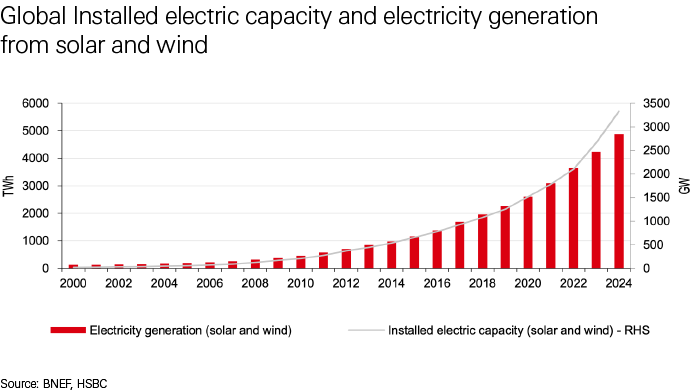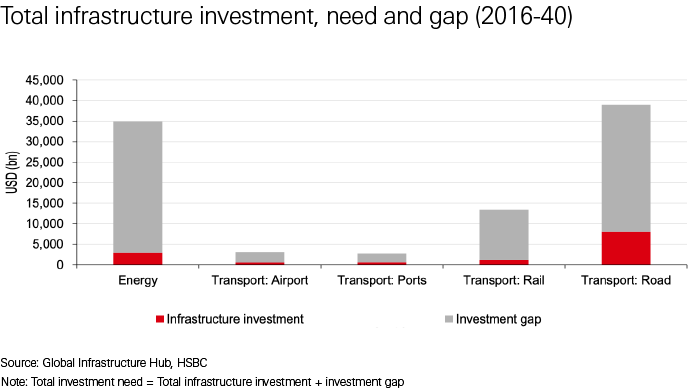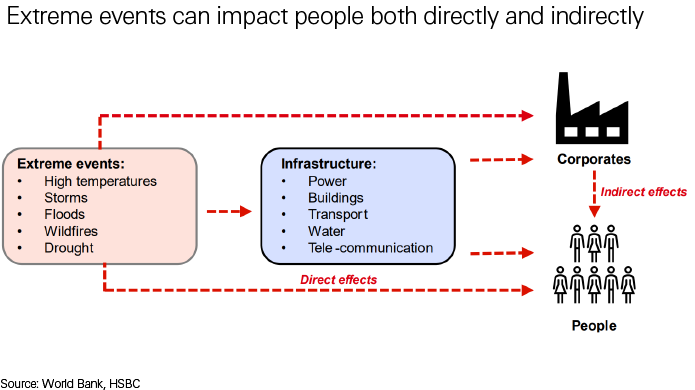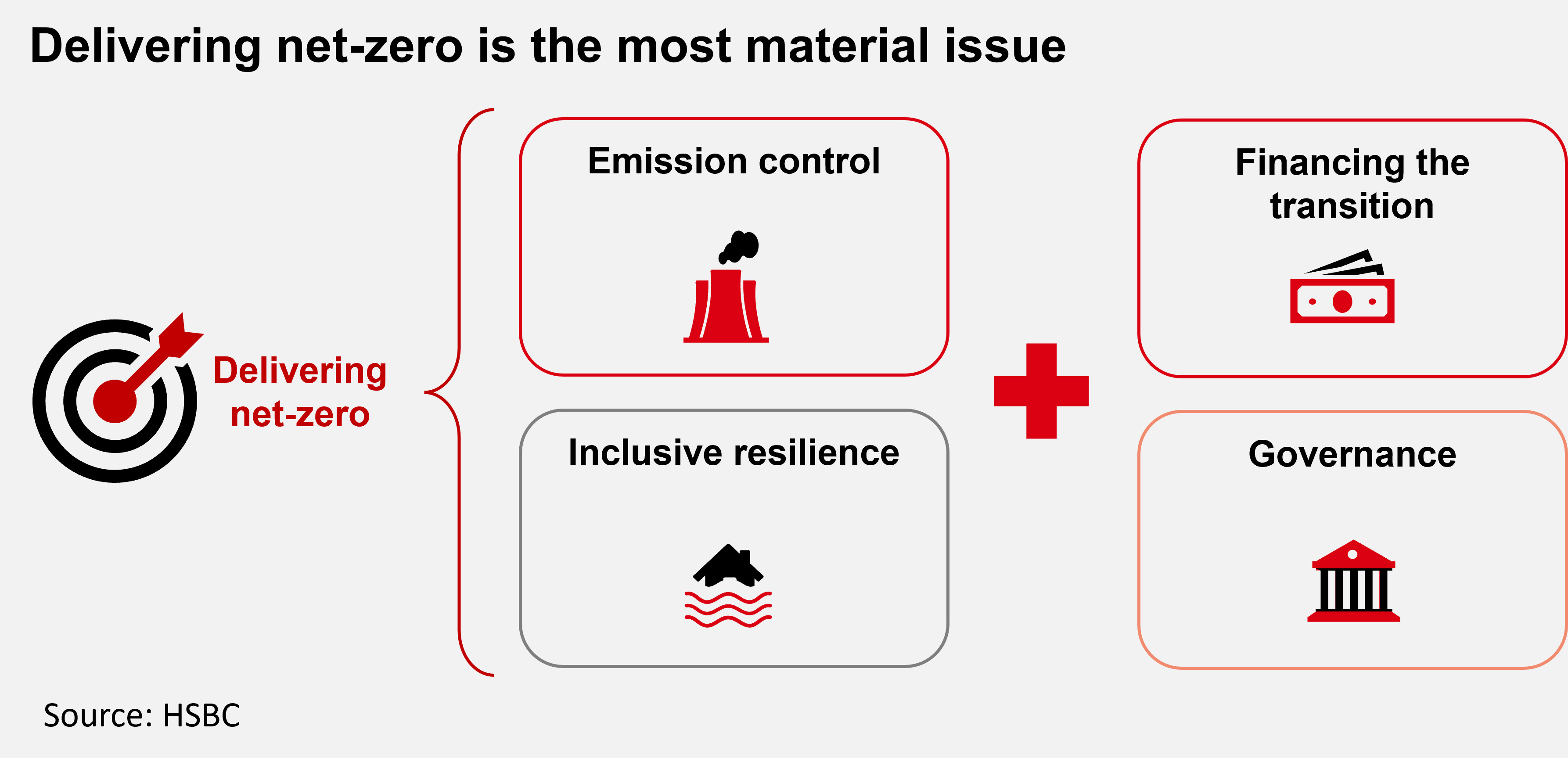- Article
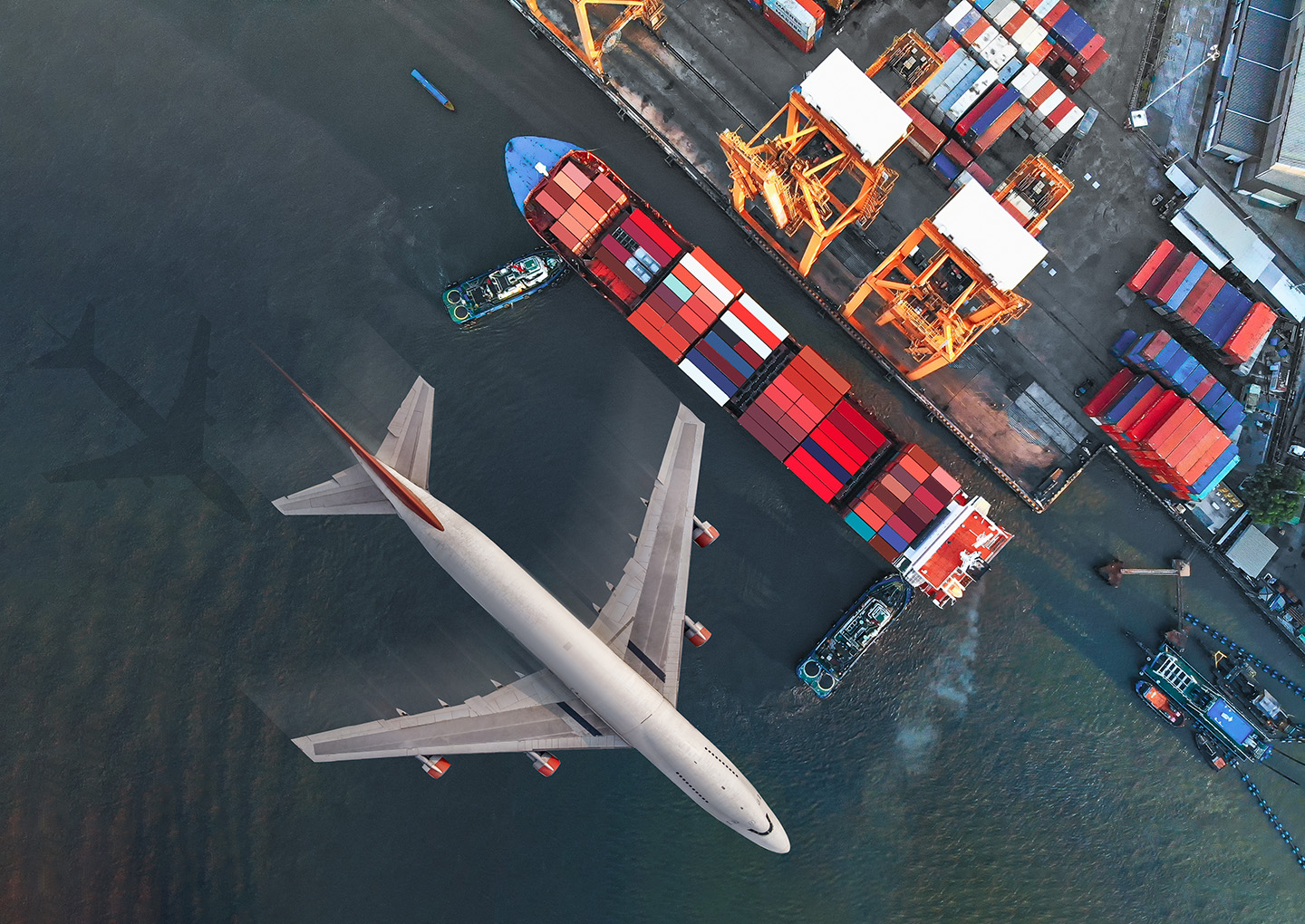
- Global Research
- Understand ESG
Net-Zero Navigator: Infrastructure
The speed of net-zero transition will be determined by the wider enabling environment to control emissions. With the power and transport sectors contributing over two-thirds of CO2 from demand for energy1, the infrastructure ecosystem to support increased demands from a growing population and industrial activity can either bring forward country decarbonisation pathways, or delay them. The speed of change is in turn determined by access to capital, and policies. We think infrastructure modernisation is a critical enabler of faster renewable electricity scale-up, economy-wide electrification, and adoption of low-carbon fuels.
From bottleneck to catalyst
Driven by population and economic activity, global energy demand and mobility needs are experiencing unprecedented growth. Meanwhile, variable renewable energy (VRE), such as solar and wind energy, is increasing its share in the global electricity mix. The evolving energy landscape has led to higher demand for power infrastructure, including electricity transmission and distribution systems, and utility-scale energy storage systems. At the same time, transport network demand has increased to support increasing passenger and commercial travel as international trade reconfigures amidst US-imposed tariffs.
As efficiency and cost of renewables has significantly improved in recent years, development and investment of renewables has outpaced that of electricity grid systems. Since existing electricity grids were not designed for high integration of renewables, intermittency of renewables could introduce instability to the grid system, forming a bottleneck towards achieving a zero-emission grid. Upgrading the transmission and distribution systems, as well as energy storage systems, could improve the balance of on-grid electricity demand and supply, and thus catalyse the adoption of renewables and decarbonisation.
For transport infrastructure, we think its role in driving net-zero transition is more diverse than power infrastructure. Airports and shipping ports could act as an enabler of low-carbon fuel adoption – sustainable aviation fuel and biofuels, which contribute to decarbonising aviation and shipping, as electrification is still far from largescale viability and commercialisation in those sectors. Rail and road transport could contribute to catalysing electrification of most of the transport sector by displacing fossil fuel-powered vehicles directly and increase the adoption of electric road vehicles.
Despite the decarbonisation potential of infrastructure modernisation, infrastructure has been underfunded due to significant capital expenditure, high cost of capital, and a longer asset lifecycle than other investment in the ecosystem. Based on the current investment trajectory, the global infrastructure investment gap would be more than USD15trn between 2016 and 2040, according to Global Infrastructure Hub. In a previous edition of the Net-zero Navigator, we highlighted that carbon-intensive industry-backed sovereign wealth funds (SWF) could provide additional sources of funding for net-zero transition. Considering the characteristics of infrastructure and the SWF mandate to provide long-term returns for the population, we think infrastructure would be a good match for portfolio diversification for SWFs. In 2023, the share of infrastructure in SWF direct investments was 20%, albeit from a low base, and long-term momentum is increasing, as shown by a five-fold increase in value since 2018, according to the International Forum of Sovereign Wealth Funds.
Infrastructure disruption driven by climate change and extreme events threaten essential services like education and health, costing between USD391bn to USD647bn annually2. This highlights the vulnerability of existing systems and the urgent need for action. Infrastructure is also key to achieving net-zero outcomes by building resilience. Resilient natural infrastructure such as wetlands, forests, and urban green spaces strengthen community resilience by integrating ecological processes into urban planning, creating spaces that are both adaptive and regenerative.
Multilateral development banks (MDBs) are important for mobilising climate infrastructure finance and derisking infrastructure projects. However, the time frame from project inception to completion can be long, and from a corporate governance perspective, the effectiveness of MDBs’ boards of directors can be a contributing factor to speed of delivery. However, there is lack of board functional diversity, including climate-related knowledge in MDBs given that most directors have a background in banking and finance (an average of 94% of non-resident BoDs and 73% for resident boards3). In addition, we think a greater focus on board socioeconomic diversity is needed to ensure inclusive culture and improve performance. In our view, greater focus on governance practices will help optimise decision-making and increase investor and other stakeholder trust.
In the full report, we identify the role that infrastructure plays in the net-zero transition, focusing on power and transport infrastructure, which have the largest investment needs at USD3.2trn annually by 20404 . On balance, we expect that the economics and pressing demand for infrastructure upgrades and rollout will be the key driver of the pace of execution. We also expect diversification of the sources of capital that fund infrastructure towards SWFs.
Would you like to find out more? Click here* to read the full note. You must be a subscriber to HSBC Global Research to access this link.
To find out more about HSBC Global Research and how to subscribe, please email us at askresearch@hsbc.com
What is the Net-Zero Navigator?
The Net-Zero Navigator is a monthly flagship report from HSBC Sustainability Research that tracks the latest developments in the net-zero space. The aim of this report is to help investors take a view on the three most material issues in terms of delivering a Net-Zero future.
*Please note that by clicking on this link you are leaving the HSBC Global Commercial Banking Website, therefore please be aware that the external site policies will differ from our website terms and conditions and privacy policy. The next site will open in a new browser window or tab.
- World Resource Institute CAIT Database
- World Bank, Underutilized Potential: The Business Costs of Unreliable Infrastructure, June 2019
- A Prizzon et al., Governance of multilateral development banks: options for reform. ODI Report, 2022
- Global Infrastructure Outlook, by Global Infrastructure Hub
The following analyst(s), who is(are) primarily responsible for this document, certifies(y) that the opinion(s), views or forecasts expressed herein accurately reflect their personal view(s) and that no part of their compensation was, is or will be directly or indirectly related to the specific recommendation(s) or views contained in this research report: Zoe Knight
This document has been issued by the Research Department of HSBC.
HSBC and its affiliates will from time to time sell to and buy from customers the securities/instruments, both equity and debt (including derivatives) of companies covered in HSBC Research on a principal or agency basis or act as a market maker or liquidity provider in the securities/instruments mentioned in this report.
Analysts, economists, and strategists are paid in part by reference to the profitability of HSBC which includes investment banking, sales & trading, and principal trading revenues.
Whether, or in what time frame, an update of this analysis will be published is not determined in advance.
For disclosures in respect of any company mentioned in this report, please see the most recently published report on that company available at www.hsbcnet.com/research.
Additional disclosures
- This report is dated as at 15 July 2025.
- All market data included in this report are dated as at close 15 July 2025, unless a different date and/or a specific time of day is indicated in the report.
- HSBC has procedures in place to identify and manage any potential conflicts of interest that arise in connection with its Research business. HSBC's analysts and its other staff who are involved in the preparation and dissemination of Research operate and have a management reporting line independent of HSBC's Investment Banking business. Information Barrier procedures are in place between the Investment Banking, Principal Trading, and Research businesses to ensure that any confidential and/or price sensitive information is handled in an appropriate manner.
- You are not permitted to use, for reference, any data in this document for the purpose of (i) determining the interest payable, or other sums due, under loan agreements or under other financial contracts or instruments, (ii) determining the price at which a financial instrument may be bought or sold or traded or redeemed, or the value of a financial instrument, and/or (iii) measuring the performance of a financial instrument or of an investment fund.
This document has been issued by HSBC Bank Middle East Ltd, DIFC, which has based this document on information obtained from sources it believes to be reliable but which it has not independently verified. Neither HSBC Bank Middle East Ltd, DIFC nor any member of its group companies (“HSBC”) make any guarantee, representation or warranty nor accept any responsibility or liability as to the accuracy or completeness of this document and is not responsible for errors of transmission of factual or analytical data, nor is HSBC liable for damages arising out of any person’s reliance on this information. The information and opinions contained within the report are based upon publicly available information at the time of publication, represent the present judgment of HSBC and are subject to change without notice.
This document is not and should not be construed as an offer to sell or solicitation of an offer to purchase or subscribe for any investment or other investment products mentioned in it and/or to participate in any trading strategy. It does not constitute a prospectus or other offering document. Information in this document is general and should not be construed as personal advice, given it has been prepared without taking account of the objectives, financial situation or needs of any particular investor. Accordingly, investors should, before acting on it, consider the appropriateness of the information, having regard to their objectives, financial situation and needs. If necessary, seek professional investment and tax advice.
The decision and responsibility on whether or not to purchase, subscribe or sell (as applicable) must be taken by the investor. In no event will any member of the HSBC group be liable to the recipient for any direct or indirect or any other damages of any kind arising from or in connection with reliance on any information and materials herein.
Past performance is not necessarily a guide to future performance. The value of any investment or income may go down as well as up and you may not get back the full amount invested. Where an investment is denominated in a currency other than the local currency of the recipient of the research report, changes in the exchange rates may have an adverse effect on the value, price or income of that investment. In case of investments for which there is no recognised market it may be difficult for investors to sell their investments or to obtain reliable information about its value or the extent of the risk to which it is exposed. Some of the statements contained in this document may be considered forward looking statements which provide current expectations or forecasts of future events. Such forward looking statements are not guarantees of future performance or events and involve risks and uncertainties. Actual results may differ materially from those described in such forward-looking statements as a result of various factors.
This document is for information purposes only and may not be redistributed or passed on, directly or indirectly, to any other person, in whole or in part, for any purpose. The distribution of this document in other jurisdictions may be restricted by law, and persons into whose possession this document comes should inform themselves about, and observe, any such restrictions. By accepting this report, you agree to be bound by the foregoing instructions. If this report is received by a customer of an affiliate of HSBC, its provision to the recipient is subject to the terms of business in place between the recipient and such affiliate. The document is intended to be distributed in its entirety. Unless governing law permits otherwise, you must contact a HSBC Group member in your home jurisdiction if you wish to use HSBC Group services in effecting a transaction in any investment mentioned in this document.
Certain investment products mentioned in this document may not be eligible for sale in some states or countries, and they may not be suitable for all types of investors. Investors should consult with their HSBC representative regarding the suitability of the investment products mentioned in this document.
HSBC and/or its officers, directors and employees may have positions in any securities in companies mentioned in this document. HSBC may act as market maker or may have assumed an underwriting commitment in the securities of companies discussed in this document (or in related investments), may sell or buy securities and may also perform or seek to perform investment banking or underwriting services for or relating to those companies and may also be represented on the supervisory board or any other committee of those companies.
From time to time research analysts conduct site visits of covered issuers. HSBC policies prohibit research analysts from accepting payment or reimbursement for travel expenses from the issuer for such visits.
HSBC Bank Middle East Ltd (“HBME”) is incorporated in the Dubai International Financial Centre, regulated by the Central Bank of the U.A.E and the Securities and Commodities Authority-License No. 602004, and lead regulated by the Dubai Financial Services Authority. Within UAE, HBME issues Research via HSBC Bank Middle East Limited, DIFC, located within the Dubai International Financial Centre and regulated by the Dubai Financial Services Authority, as well as through HSBC Bank Middle East Limited UAE branch, regulated by the Securities and Commodities Authority under License No. 602004 (Fifth Category) for Financial Consultation and Financial Analysis.
© Copyright 2025, HSBC Bank Middle East Ltd, DIFC ALL RIGHTS RESERVED. No part of this publication may be reproduced, stored in a retrieval system, or transmitted, on any form or by any means, electronic, mechanical, photocopying, recording, or otherwise, without the prior written permission of the issuer of the report.
Issuer of report
HSBC Bank Middle East Ltd, DIFC
Net-Zero Navigator: Where will the money come from?
Transitioning to a net-zero economy requires substantial investment.



